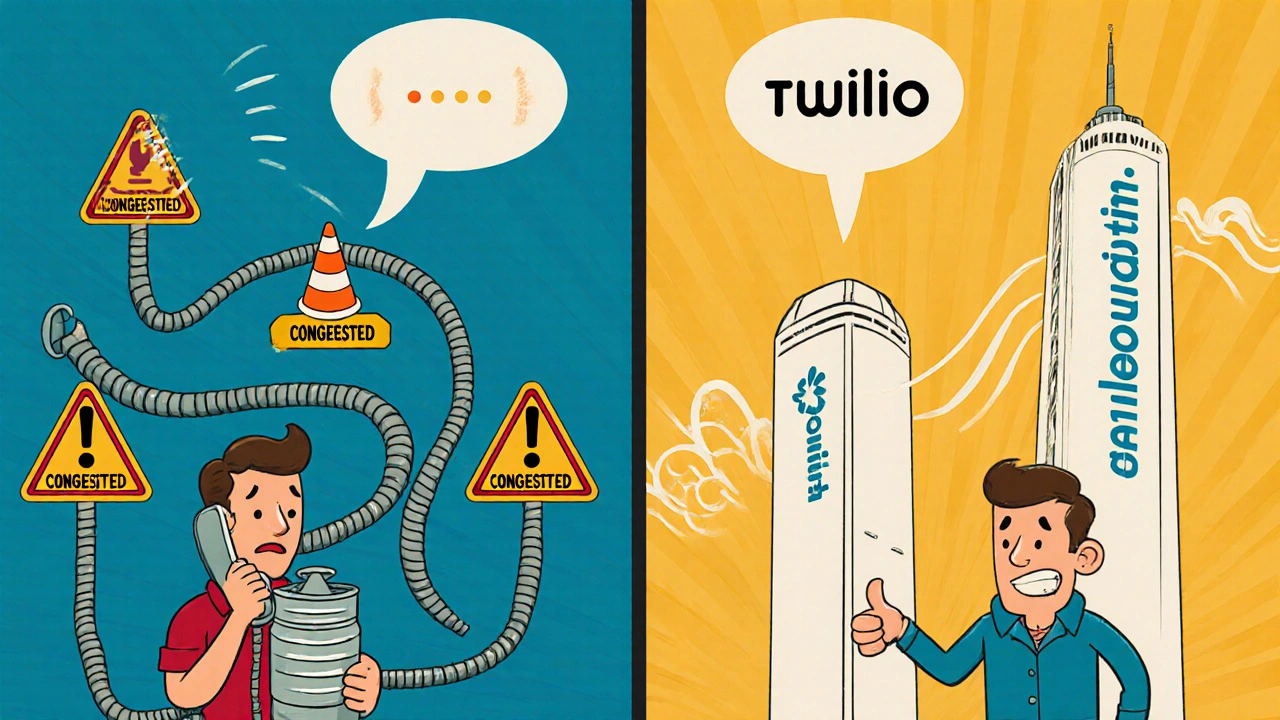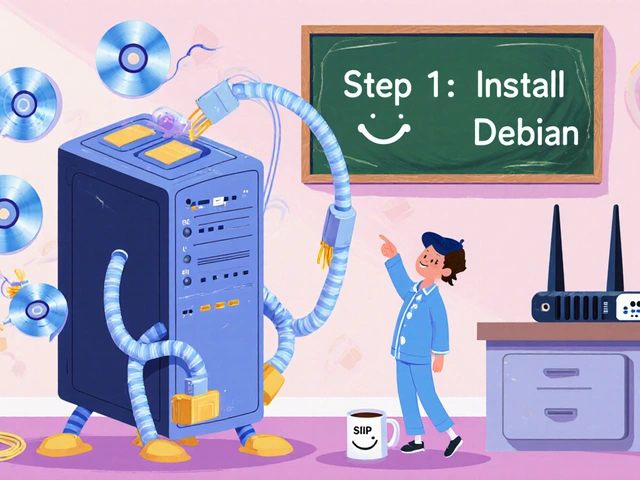Have you ever been on a VoIP call that sounded like it was coming through a tin can? Or worse-heard a three-second delay before the other person responded, causing you both to talk over each other? That’s not your microphone. It’s not your headphones. It’s the path your voice took across the internet.
What ISP Peering Actually Does for Your Calls
When you make a VoIP call, your voice gets broken into tiny digital packets. These packets don’t fly through the air-they hop from one network to another, like a relay race across the globe. The problem? Not all networks like each other. That’s where peering comes in.
Peering is when two internet service providers (ISPs) or VoIP companies agree to connect directly. No middleman. No extra stop. Think of it like two neighbors building a shortcut between their houses instead of walking through the whole neighborhood to get to each other. When VoIP providers peer, your call skips 5-10 extra network hops. That’s not just faster-it’s clearer.
Direct peering cuts latency. It reduces packet loss. And it stabilizes jitter. In real numbers: calls between two peered networks hit 98.7 MOS (Mean Opinion Score, where 5 is perfect). Calls routed through third-party transit? They drop to 89.2 MOS. That’s the difference between a crisp, natural conversation and one where you keep saying, “Wait, what?”
How Routing Turns Good Calls Bad
Even if your provider peers with others, the route your call takes matters. Routing is the GPS for your data packets. If the system picks a long, winding path because it’s cheaper-or because the direct route is congested-your call suffers.
Here’s what breaks VoIP quality:
- Latency over 150ms: You start to notice delays. Conversations feel awkward. People talk over each other.
- Latency over 300ms: Normal conversation becomes impossible. It feels like talking to someone on Mars.
- Packet loss above 1%: Every extra percent drops your MOS by 0.2-0.4 points. At 2%, your voice starts cutting out in chunks.
- Jitter above 50ms: Your audio stutters, clicks, or goes silent. Buffers can only fix so much.
One business in Madison switched VoIP providers and saw their packet loss drop from 2.1% to 0.4% just because their new provider had a local point of presence (PoP). Their call quality went from “unusable during meetings” to “better than landline.”
Why Your Local Internet Isn’t the Problem
You might think upgrading your home internet will fix bad VoIP calls. It won’t. If your provider routes your call through three different transit networks to reach someone in another state, your 1Gbps fiber connection won’t help. The bottleneck isn’t your router-it’s the route your call takes after it leaves your network.
That’s why enterprise buyers now ask vendors one key question: “Where are your peering points?” Not “What’s your bandwidth?” Not “Do you have QoS?” But where you connect. Providers with 20-50+ global PoPs (like Twilio or Bandwidth.com) consistently outperform those with fewer than 15. Why? Fewer hops. Fewer chances for something to go wrong.
And here’s the kicker: rural businesses suffer more. A 2023 study found rural users had 2.3 times more call drops than urban ones-not because their internet was slower, but because they had fewer ISP options. Their VoIP provider had to route calls through distant transit networks just to reach major hubs.

What You Can Do: Ask the Right Questions
If you’re choosing a VoIP provider, don’t just pick the cheapest one. Ask these five questions before signing:
- How many Points of Presence (PoPs) do you operate, and where are they located?
- What’s your average latency to major cloud regions like AWS, Google Cloud, and Azure?
- Can you show me packet loss and jitter stats by region-especially for the cities I call most?
- Do you peer directly with other VoIP providers, or do you rely on Universal Long Distance Carriers (ULCs)?
- Do you use AI-driven routing to dynamically choose the best path in real time?
Reputable providers will have this data ready. If they can’t or won’t share it, that’s a red flag. The FCC now requires VoIP providers to disclose these metrics-so if they’re hiding them, they’re probably not proud of them.
QoS Alone Won’t Save You
You’ve probably heard: “Just enable QoS on your router.” That helps-but only if your traffic stays on a clean path. If your VoIP packets get dumped into a congested transit link halfway across the country, even perfect DSCP tagging (EF PHB with value 46) won’t help. QoS prioritizes traffic within your network. It doesn’t fix bad routing outside it.
One healthcare provider in Wisconsin reduced critical call failures from 8.2% to 0.7% by doing two things: separating voice and data traffic with VLANs, and switching to a provider with direct peering to their electronic health records system. They didn’t upgrade their internet. They upgraded their route.

The Future Is Community Peering
The VoIP market is changing fast. In 2020, the top 10 providers controlled 48% of the enterprise market. By 2024, that jumped to 63%. Why? Because quality is now the biggest differentiator. Gartner predicts the MOS gap between top and bottom providers will hit 1.2 points by 2026-enough to make one provider feel professional and another feel broken.
Smaller providers are teaming up through community peering networks. Instead of paying expensive transit fees, they connect directly with each other. Omdia predicts this will cut reliance on traditional transit providers by 35-45% by 2027. That’s good news for everyone-especially businesses that need reliable international calls.
But watch out for new risks. Security researchers at the ITU found that 12% of VoIP deployments cut corners on encryption to chase lower latency. If your provider skips SRTP encryption to save milliseconds, your calls might be faster-but also easier to eavesdrop on.
Bottom Line: Your Call Quality Is a Network Choice
VoIP isn’t just about software. It’s about infrastructure. The difference between a crystal-clear call and a frustrating one isn’t your phone. It’s not your Wi-Fi. It’s whether your provider has built the right connections across the internet.
If you’re still using a VoIP service that doesn’t talk about peering or routing, you’re using yesterday’s technology. The best providers don’t just sell you a phone system-they give you a network that’s built for voice. And in 2025, that’s not a luxury. It’s the baseline.
What’s the biggest factor affecting VoIP call quality?
The biggest factor is the path your call takes across the internet-specifically, how many network hops it makes and whether it travels through direct peering connections or third-party transit. Latency, packet loss, and jitter are symptoms of poor routing and peering decisions, not the root cause.
Can I fix bad VoIP quality by upgrading my home internet?
Upgrading your home internet won’t fix poor VoIP quality if your provider routes calls through congested or indirect paths. You need a VoIP provider that peers directly with networks you call often. Your local bandwidth helps, but it’s not the deciding factor.
What’s an acceptable latency for VoIP calls?
For natural, uninterrupted conversation, latency should stay under 150ms. Above 150ms, delays become noticeable. Above 300ms, normal conversation becomes nearly impossible. Most enterprise-grade VoIP services aim for 80-120ms.
What does “Tier-1 network” mean for VoIP providers?
A Tier-1 network is one that can reach every other network on the internet without paying for transit. For VoIP, this means the provider has direct peering with most major networks, reducing hops and improving reliability. Providers advertising this usually have 20+ global PoPs and avoid middlemen.
Why do international calls sound worse than local ones?
Most VoIP providers have strong peering in their home region but rely on expensive transit links for international routes. If your provider doesn’t peer directly with networks in the countries you call, your traffic gets routed through multiple intermediaries-adding latency and packet loss. Look for providers with global PoPs or dedicated international peering.
Should I use VLANs for VoIP traffic?
Yes-if you’re in a business environment. Separating voice and data traffic with VLANs reduces congestion-related call issues by 65-78%. It also makes QoS more effective because voice packets aren’t competing with file downloads or video streams.
Is AI routing worth it for VoIP?
Yes, especially for businesses with high call volume or global reach. AI-driven routing analyzes real-time network conditions and picks the best path for each call. Providers like Twilio and Bandwidth use it to reduce latency by 22ms and packet loss by 0.35% on average-small numbers that add up to noticeably better calls.









chioma okwara
30 Oct 2025 at 04:33yo i read this whole thing and honestly the only thing that matters is peering points. if your provider routes through some middleman in frankfurt just to reach a server in chicago, your call is doomed. i work in telecom and i’ve seen companies pay $200/mo for ‘enterprise VoIP’ only to have calls drop every time someone in london calls ny. fix the path, not the router. also its ‘point of presence’ not ‘pop’ unless you wanna sound like a noob